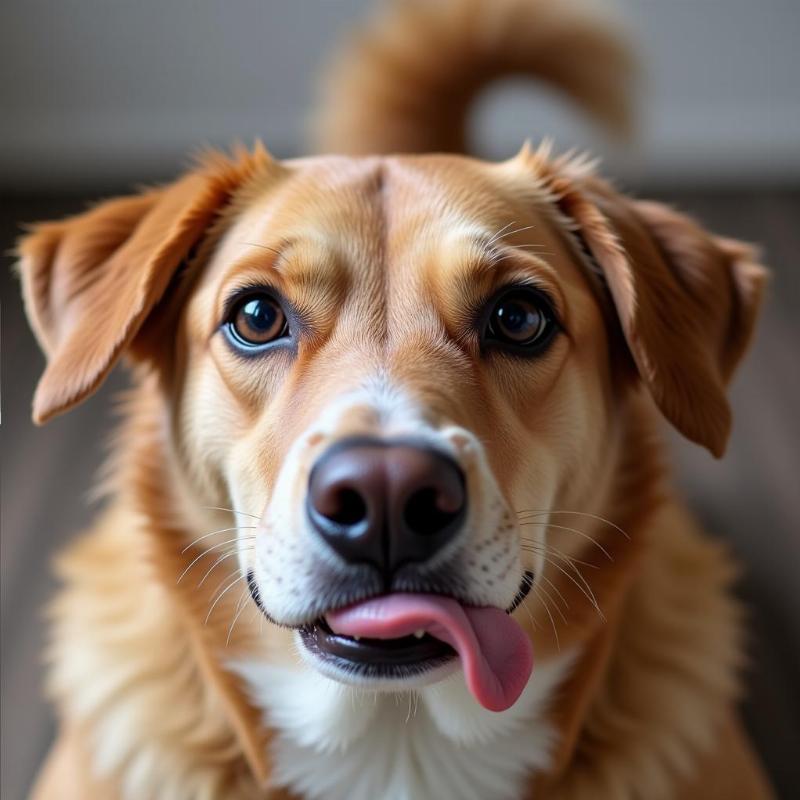Introducing a new puppy to any dog requires careful planning, but when your resident dog is reactive, the process needs extra sensitivity and patience. A reactive dog might exhibit fear, aggression, or excessive excitement, making introductions challenging. This guide will provide you with a step-by-step approach on how to introduce a puppy to a reactive dog, minimizing stress and maximizing the chances of a harmonious relationship.
Understanding Your Reactive Dog’s Triggers
Before introducing the puppy, it’s crucial to understand your reactive dog’s triggers. Is it other dogs, specific noises, sudden movements, or something else entirely? Knowing these triggers allows you to anticipate potential problems and create a controlled environment for the initial introduction. Observe your dog’s body language: tucked tail, whale eye (showing the whites of their eyes), lip licking, and yawning can all be signs of stress.
 Reactive Dog Showing Stress Signs
Reactive Dog Showing Stress Signs
Gradual Introduction: Scent Before Sight
Start with scent introductions. Keep the puppy and your reactive dog completely separated initially. Swap blankets or toys between them so they can become familiar with each other’s scent. Feed them on opposite sides of a closed door, allowing them to associate positive experiences (mealtime) with the other’s smell. This helps build a positive association before they even see each other.
The First Meeting: Controlled and Supervised
For the first visual introduction, choose a neutral, quiet location, preferably outdoors, where your reactive dog feels less territorial. Both dogs should be on leashes, held by separate handlers. Keep the leashes loose to avoid adding tension. Allow them to see each other briefly from a distance, then redirect their attention with treats or toys. If either dog shows signs of stress, increase the distance. The goal is to create a calm and positive first impression.
Parallel Walks: Building Positive Associations
Once both dogs seem comfortable with brief visual contact, start parallel walks. Walk them on opposite sides of the street or at a comfortable distance in a park, gradually decreasing the distance over several sessions as they show signs of relaxation. This allows them to become accustomed to each other’s presence without direct interaction, while associating the pleasant activity of walking with the other dog.
Short, Supervised Play Sessions: Monitoring Interactions
When the parallel walks are going smoothly, you can introduce short, supervised play sessions in a safe, enclosed area. Keep the sessions brief and positive, ending them before either dog shows signs of stress or overstimulation. Provide plenty of toys and treats to keep them occupied and focused on positive interactions.
Managing Expectations and Patience
Remember that introducing a puppy to a reactive dog is a process that requires patience and understanding. Not all dogs will become best friends, and that’s okay. The goal is to create a peaceful coexistence where both dogs feel safe and comfortable in each other’s presence. Continue to manage interactions and provide positive reinforcement.
Conclusion
Introducing a puppy to a reactive dog requires careful planning, patience, and a deep understanding of your dog’s triggers. By following a gradual introduction process, focusing on positive reinforcement, and managing expectations, you can significantly increase the chances of a successful integration. Remember, every dog is an individual, so adapt these guidelines to your specific situation.
FAQs
- What if my reactive dog shows aggression towards the puppy? Immediately separate the dogs and consult with a certified professional dog trainer or veterinary behaviorist.
- How long will it take for my reactive dog to accept the puppy? This varies greatly depending on the individual dog, their reactivity level, and the consistency of your approach. It can take weeks, months, or even longer.
- Should I let the puppy interact with my reactive dog unsupervised? Never leave a puppy and a reactive dog unsupervised, especially during the initial stages of introduction.
- What if my reactive dog doesn’t seem to be warming up to the puppy? Continue with gradual introductions and seek professional guidance if needed. A peaceful coexistence is a realistic goal, even if they don’t become close friends.
- Can I use medications to help my reactive dog during the introduction process? Consult with your veterinarian to discuss whether medication might be beneficial for your reactive dog.
Related Articles
- how to introduce reactive dog to puppy
- how to introduce a reactive dog to a puppy
- what does heel mean for dogs
Beautdogs.us is your premier destination for all things dog-related in the USA. We offer expert advice on dog breeds, care, and training, as well as insights into the latest products and services for your canine companion. Whether you’re a seasoned dog owner or just starting your journey, Beautdogs.us provides reliable, comprehensive, and engaging information to enhance the bond with your furry friend. Contact us today for personalized advice and support! Email: [email protected], Phone: +1 501-555-7529.